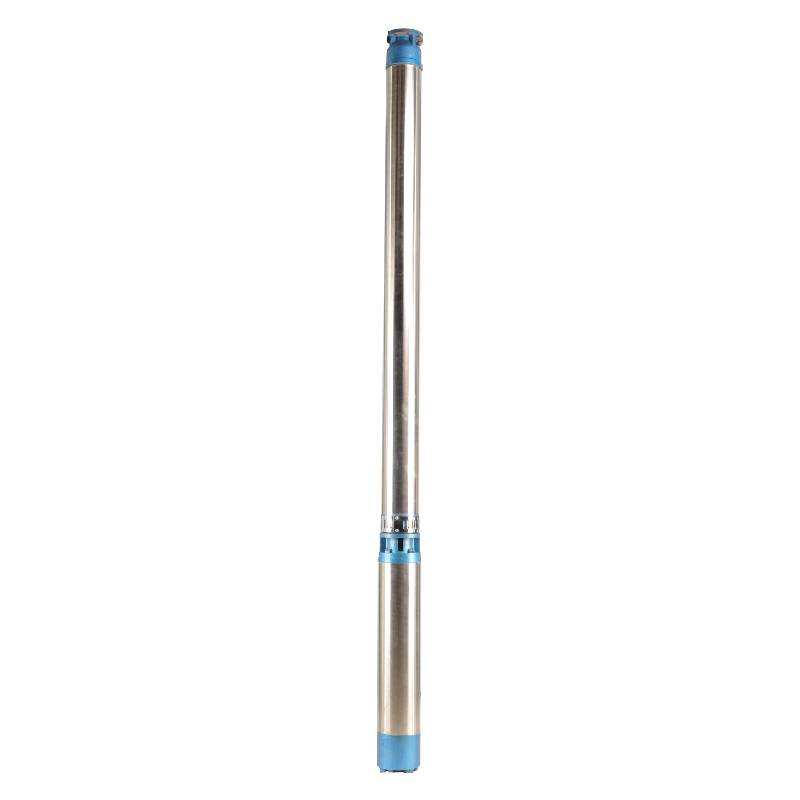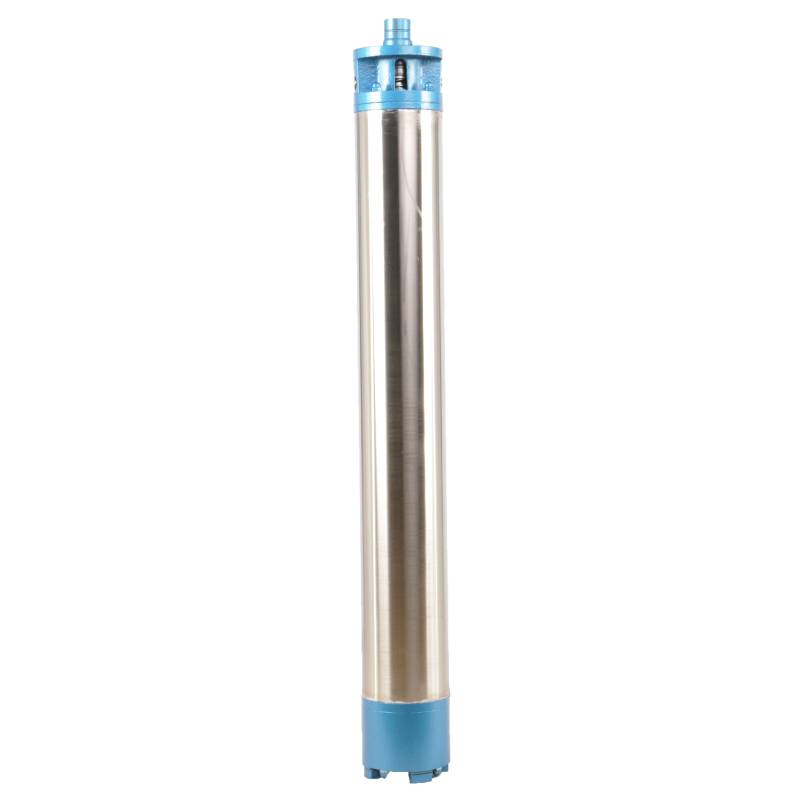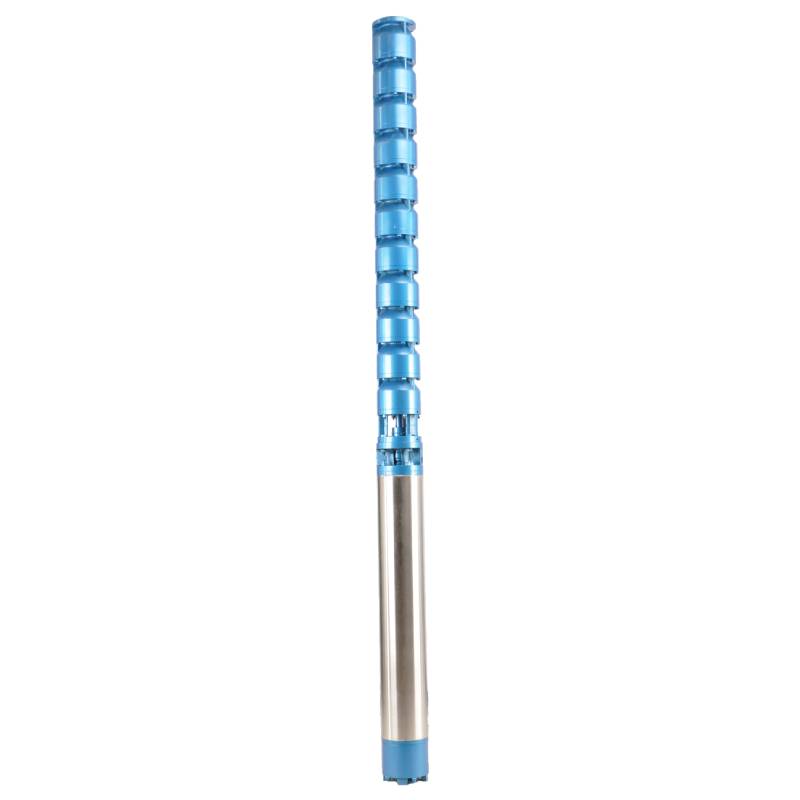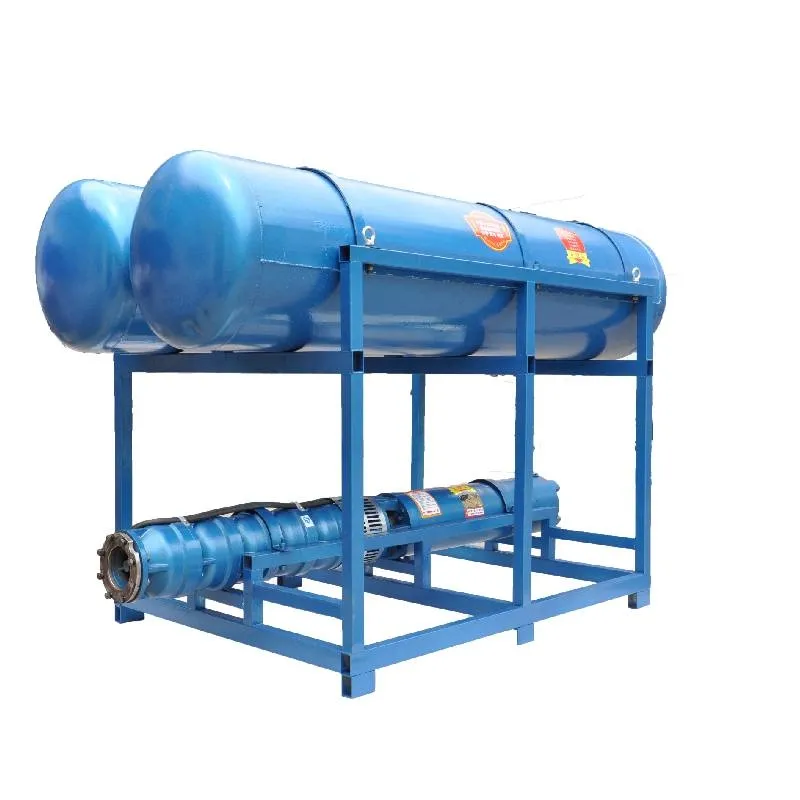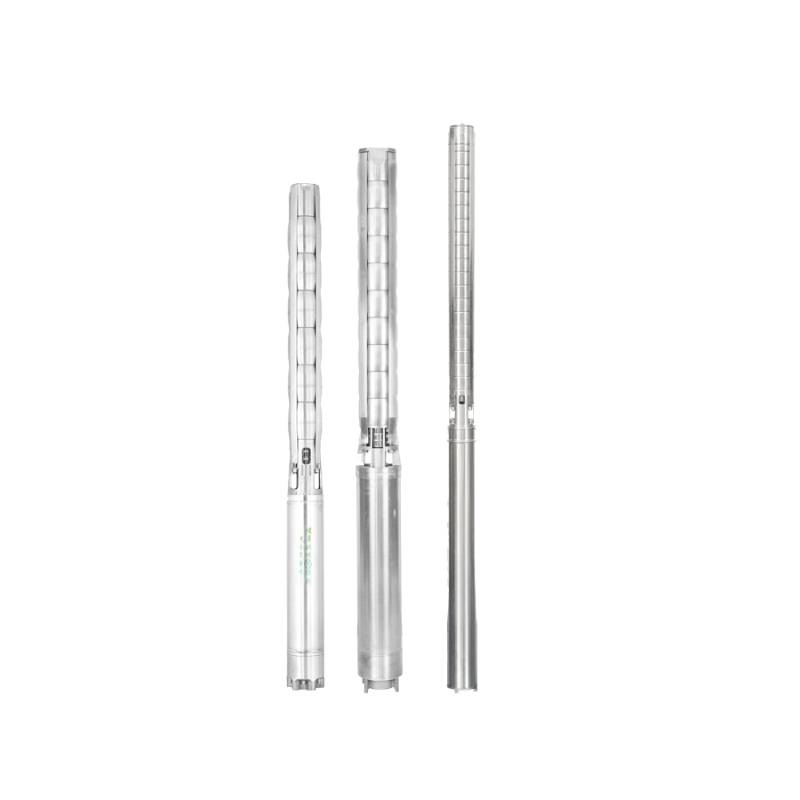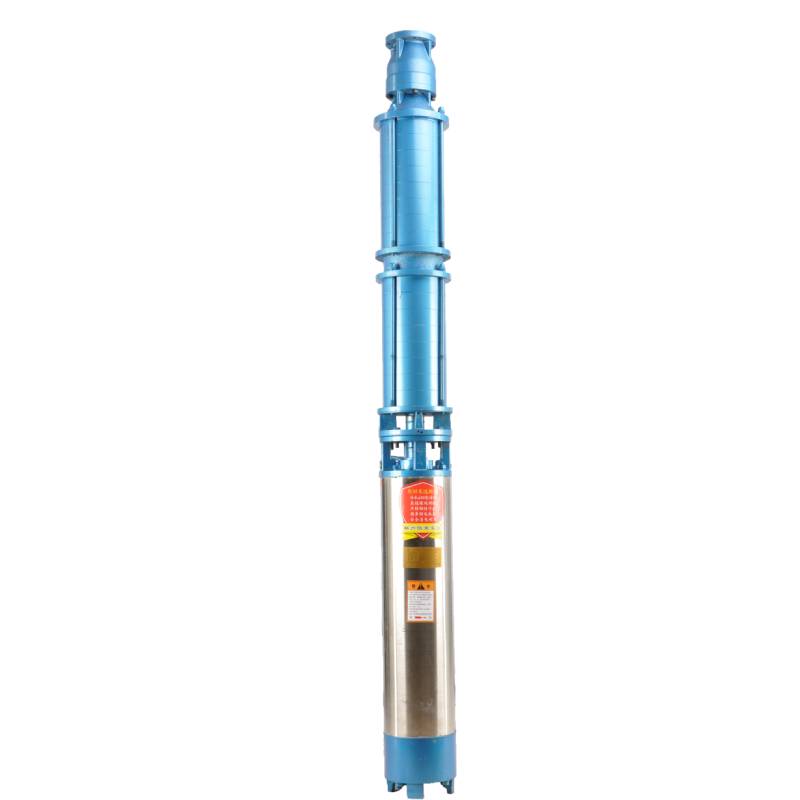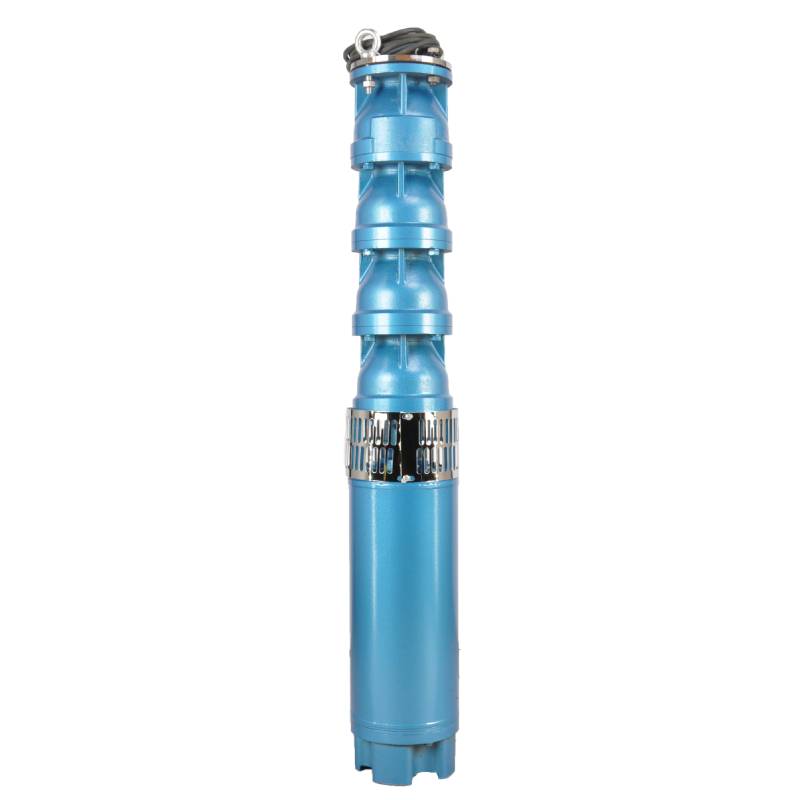QJ series submersible pump is a kind of lifting machine directly connected to the submersible motor and pump to work in the water. This series of pumps is vertical, small footprint, compact structure, simple installation, easy maintenance and repair. It is widely used in agricultural irrigation, municipal engineering, water conservancy projects, urban water supply and drainage and industrial and mining enterprises, drought relief and drainage, etc. The flow range is 5-500m3/h, the head is 4-800m, and the power is 3-315KW. This submersible pump can efficiently lift and transport water, providing reliable water supply for various fields. Its stable performance and solid structure make it an indispensable machine and equipment for various water conservancy projects.
The power supply of this product is three-phase AC 380V (tolerance ± 5%), 50HZ (tolerance ± 1%).
The water quality shall meet the following requirements:
(1) the water temperature shall not be higher than 20 °C;
(2) the content of solid impurities (mass ratio) shall not exceed 0.01%;
(3) the PH value (acidity and alkalinity) is 6.5-8.5;
(4) the content of hydrogen sulfide shall not exceed 1.5mg/L;
(5) the content of chloride ions shall not be higher than 400mg/L.
The motor is a closed or water-immersed wet structure. Before use, the inner cavity of the submersible motor shall be filled with water to prevent empty, and then the water injection and air exhaust bolts shall be tightened, otherwise it shall not be used. The submersible pump must be completely immersed in water to work, and the immersion depth shall not exceed 70 meters, and the distance between the bottom of the pump and the bottom of the well shall not be less than 3 meters. The well water inflow shall meet the water output and continuous operation requirements of the submersible pump, and the output water shall be controlled at 0.7-1.2 times of the rated flow. The well shall be vertical, and the submersible pump shall not be used horizontally or inclined, but only vertically. The submersible pump shall be equipped with cables as required, and equipped with external overload protection devices. It is strictly prohibited to conduct no-water no-load test on the pump.
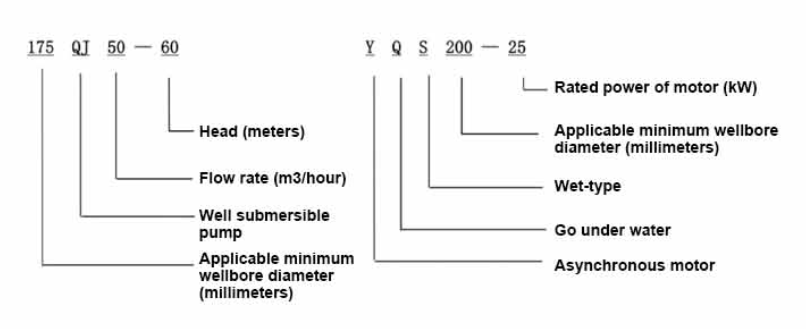
| Hoʻohālike | Kahe (m3/h) | Poʻo (m) |
Holoi wikiwiki (hoʻololi / kiko) |
Pum wai(%) | puka puka anawaena (mm) |
Kūpono maikaʻi anawaena(mm) |
Heluhelu ʻia mana(KW) |
Heluhelu ʻia uila (V) |
Heluhelu ʻia kēia manawa(A) |
Kaʻa kaʻa (%) | power factorcosφ | Unite Ka nui o ka Radial (mm) |
ʻŌlelo | |||||||||
| 135QJ5-34 | 5 | 34 | 2850 | 40 | 135maluna | 1.5 | 380 | 4.23 | 128 | |||||||||||||
| 135QJ5-51 | 51 | 2.2 | 6.03 | |||||||||||||||||||
| 135QJ5-68 | 68 | 3 | 8.01 | |||||||||||||||||||
| 135QJ5-85 | 85 | 4 | 10.53 | |||||||||||||||||||
| 135QJ5-102 | 102 | 5.5 | 14.1 | |||||||||||||||||||
| 135QJ5-119 | 119 | 5.5 | 14.1 | |||||||||||||||||||
| 135QJ5-240 | 240 | 11 | 26.28 | |||||||||||||||||||
| 135QJ5-280 | 5 | 280 | 2850 | 40 | 135maluna | 13 | 380 | 30.87 | 128 | |||||||||||||
| 135QJ5-320 | 320 | 15 | 35.62 | |||||||||||||||||||
| 135QJ10-24 | 10 | 24 | 2850 | 50 | 135maluna | 1.5 | 380 | 4.23 | 128 | |||||||||||||
| 135QJ10-32 | 32 | 2.2 | 6.03 | |||||||||||||||||||
| 135QJ10-48 | 48 | 3 | 8.01 | |||||||||||||||||||
| 135QJ10-56 | 56 | 4 | 10.53 | |||||||||||||||||||
| 135QJ10-72 | 72 | 5.5 | 14.1 | |||||||||||||||||||
| 135QJ10-80 | 80 | 5.5 | 14.1 | |||||||||||||||||||
| 135QJ10-104 | 104 | 7.5 | 19.0 | |||||||||||||||||||
| 135QJ10-120 | 120 | 7.5 | 19.0 | |||||||||||||||||||
| 135QJ10-136 | 136 | 9.2 | 22.7 | |||||||||||||||||||
| 135QJ10-180 | 180 | 11 | 26.28 | |||||||||||||||||||
| 135QJ10-210 | 210 | 13 | 30.87 | |||||||||||||||||||
| 135QJ10-240 | 240 | 15 | 35.62 | |||||||||||||||||||
| 135QJ10-300 | 300 | 18.5 | 43.12 | |||||||||||||||||||
| 135QJ15-36 | 15 | 36 | 2850 | 50 | 135maluna | 2.2 | 380 | 6.03 | 128 | |||||||||||||
| 135QJ15-39 | 39 | 3 | 8.01 | |||||||||||||||||||
| 135QJ15-46 | 46 | 4 | 10.53 | |||||||||||||||||||
| 135QJ15-52 | 52 | 4 | 10.53 | |||||||||||||||||||
| 135QJ15-59 | 59 | 5.5 | 14.1 | |||||||||||||||||||
| 135QJ15-65 | 65 | 5.5 | 14.1 | |||||||||||||||||||
| 135QJ15-78 | 78 | 7.5 | 19.0 | |||||||||||||||||||
| 135QJ15-91 | 91 | 7.5 | 19.0 | |||||||||||||||||||
| 135QJ15-104 | 104 | 9.2 | 22.7 | |||||||||||||||||||
| 135QJ15-120 | 120 | 11 | 26.28 | |||||||||||||||||||
| 135QJ15-142 | 142 | 13 | 30.87 | |||||||||||||||||||
| 135QJ15-162 | 162 | 15 | 35.62 | |||||||||||||||||||
| 135QJ15-200 | 200 | 18.5 | 43.12 | |||||||||||||||||||
| 135QJ20-16 | 20 | 16 | 2850 | 50 | 135above | 2.2 | 380 | 6.03 | 128 | |||||||||||||
| 135QJ20-24 | 24 | 3 | 8.01 | |||||||||||||||||||
| 135QJ20-32 | 32 | 4 | 10.53 | |||||||||||||||||||
| 135QJ20-40 | 40 | 4 | 10.53 | |||||||||||||||||||
| 135QJ20-48 | 48 | 5.5 | 14.1 | |||||||||||||||||||
| 135QJ20-56 | 56 | 5.5 | 14.1 | |||||||||||||||||||
| 135QJ20-64 | 64 | 7.5 | 19.0 | |||||||||||||||||||
| 135QJ20-72 | 72 | 7.5 | 19.0 | |||||||||||||||||||
| 135QJ20-80135QJ20-100 | 80 | 9.2 | 22.7 | |||||||||||||||||||
| 100 | 11 | 26.28 | ||||||||||||||||||||
| 135QJ20-120 | 120 | 13 | 30.87 | |||||||||||||||||||
| 135QJ20-136 | 136 | 15 | 35.62 | |||||||||||||||||||
| 135QJ20-168135QJ25-12 | 168 | 18.5 | 43.12 | |||||||||||||||||||
| 25 | 12 | 2850 | 65 | 135maluna | 2.2 | 380 | 6.03 | 128 | ||||||||||||||
| 135QJ25-18 | 18 | 3 | 8.01 | |||||||||||||||||||
| 135QJ25-24 | 24 | 4 | 10.53 | |||||||||||||||||||
| 135QJ25-30 | 30 | 4 | 10.53 | |||||||||||||||||||
| 135QJ25-36 | 36 | 5.5 | 14.1 | |||||||||||||||||||
| 135QJ25-48 | 48 | 7.5 | 19.0 | |||||||||||||||||||
| 135QJ25-60 | 60 | 9.2 | 22.7 | |||||||||||||||||||
| 135QJ25-82 | 82 | 11 | 26.28 | |||||||||||||||||||
| 135QJ25-97 | 97 | 13 | 30.87 | |||||||||||||||||||
| 135QJ25-110 | 110 | 15 | 35.62 | |||||||||||||||||||
| 135QJ25-130 | 130 | 18.5 | 43.12 | |||||||||||||||||||
| 135QJ32-24 | 32 | 24 | 2850 | 80 | 135maluna | 4 | 380 | 10.53 | 128 | |||||||||||||
| 135QJ32-30 | 30 | 5.5 | 14.1 | |||||||||||||||||||
| 135QJ32-42 | 42 | 7.5 | 19.0 | |||||||||||||||||||
| 135QJ32-54 | 54 | 9.2 | 22.7 | |||||||||||||||||||
| 135QJ32-68 | 68 | 11 | 26.28 | |||||||||||||||||||
| 135QJ32-80 | 80 | 13 | 30.87 | |||||||||||||||||||
| 135QJ32-92 | 92 | 15 | 35.62 | |||||||||||||||||||
| 135QJ32-104 | 104 | 18.5 | 43.12 | |||||||||||||||||||
| 135QJ40-46 | 40 | 46 | 2850 | 80 | 135maluna | 11 | 380 | 26.28 | 128 | |||||||||||||
| 135QJ40-54 | 54 | 13 | 30.87 | |||||||||||||||||||
| 135QJ40-62 | 62 | 15 | 35.62 | |||||||||||||||||||
| 135QJ40-84 | 84 | 18.5 | 43.12 | |||||||||||||||||||
1, ʻo ka pauma hoʻohaʻahaʻa maikaʻi no ka pauma wai maʻemaʻe, pāpā i ka luawai hou, ka hoʻoheheʻe ʻana i ka lepo a me ka wai lepo,
2, maikaʻi ka wai puna wai uila helu 380/50HZ, ka hoʻohana ʻana i nā māka uila ʻē aʻe o nā motika submersible pono e hana maʻamau. Pono e hoʻohana i ke kaula wai ʻole, pono e hoʻolako ʻia me nā mea hoʻomaka, e like me ka pahu hāʻawi, hoʻomaka ʻaʻole mākaukau pono e hoʻohana maʻamau i ka hana hoʻomalu holoʻokoʻa holoʻokoʻa, e like me ka pale pōkole overload, pale ʻāpana, pale undervoltage, pale ʻāina, pale pale , inā loaʻa nā kūlana kūpono ʻole, pono ka mea pale e hele i ka manawa hana.
3, pono e hoʻokumu pono ʻia ka hoʻonohonoho ʻana a me ka hoʻohana ʻana i ka paila, pāpā i ka pana a huki i ka wā e pulu ai nā lima a me nā wāwae, pono e ʻoki i ka lako mana ma mua o ka hoʻokomo ʻana a me ka mālama ʻana i ka pama, kahi e hoʻohana ai ka paila e hoʻonohonoho " no ka pale ʻana i ka haʻalulu uila" nā hōʻailona maopopo:
4, i lalo o ka luawai a i ʻole ma mua o ka hoʻokomo ʻana, pono e hoʻopiha ʻia ka lua kaʻa me ka wai i hoʻomaʻemaʻe ʻia a i ʻole ka wai hoʻolapalapa maʻemaʻe maʻemaʻe maʻemaʻe, e hoʻopaʻa i ka pahu wai, ka paila ma ka hoʻāʻo ʻana o ka honua, pono i ka pahu wai lubrication rubber. nā bearings, hoʻomaka koke ʻaʻole ʻoi aku ma mua o hoʻokahi kekona, e ʻike inā like ka hoʻokele me ke kuhikuhi hoʻokele. Ke kū pololei ka paila, e hoʻolohe i ka palekana, e pale i ka hoʻohuli ʻana i ka ʻeha.
5, e like me nā ʻōlelo o ka hoʻokiʻekiʻe ʻana o ka pauma, ke kahe o ka hoʻohana ʻana, e pale i ke kahe haʻahaʻa a i ʻole ka hoʻokiʻekiʻe kiʻekiʻe o ka pumping ikaika, ke kuʻi ʻana a me nā ʻāpana ʻē aʻe o ka ʻaʻahu, ua wela ke kaʻa.
6, after the pump down the well, the measurement of the motor to the ground insulation resistance should not be less than 100M, after the start to observe the voltage and current, check the motor winding insulation, whether in line with the requirements; pump storage location temperature if less than freezing point, should be dry the motor cavity water, prevent the motor cavity water ice damage caused by low temperature.
1.Structure brief: pump part is mainly composed of pump shaft, impeller, diversion shell, rubber bearing, check valve body (optional parts) and other components. The motor part is mainly composed of base, pressure regulating film, thrust bearing, thrust plate, lower guide bearing seat, stator, rotor, upper guide bearing seat, sand throwing ring, water inlet node, cable and other components
2.The main feature of this product is the use of water-cooled wet submersible three-phase asynchronous motor. The motor chamber is filled with water, used to cool the motor and lubricate the bearing. The voltage regulating film at the bottom is used to adjust the pressure difference caused by the temperature rise of the motor. In order to prevent the sand in the well water from entering the motor, two oil seals are installed on the top of the motor shaft extension end, and a sand throwing ring is installed to form a sand control structure. This design ensures the long-term reliability and stability of the motor, which is an ideal choice for pump users.
3. In order to prevent the pump shaft from running up when starting, the pump shaft and the motor shaft are connected by a coupling, and an upper thrust bearing is installed under the motor.
4.The lubrication of the motor and the pump bearing is water lubrication.
5.he motor stator winding is made of high quality submersible motor winding wire, with high insulation performance.
6. The pump is designed by computer CAD, with simple structure and good technical performance.

(1) Hoʻomākaukau ma mua o ke kau ʻana:
1. E nānā inā kūpono ka pauma submersible i nā kūlana hoʻohana a me ka laulā i ʻōlelo ʻia ma ka manual.
2. Ma ka hoʻohana ʻana i kahi obiect kaumaha me ke anawaena e like me ke anawaena o waho loa o ka pauma hoʻohaʻahaʻa, e ana inā hiki i ka inneldiameter o ka luawai ke hoʻokomo i ka pauma hoʻoheheʻe ʻia, a e ana i ka hoʻokō ʻana o ka hohonu i nā koi hoʻokomo.
3. E nānā i ka maʻemaʻe o ka luawai a me ka wai o ka pūnāwai. Mai hoʻohana i ka pauma uila e holoi ai i ka ʻōpala welor a me ka wai one no ka pale ʻana i ka pōʻino mua o ka pauma uila.
4. E nānā inā kūpono ke kūlana o ka hoʻopili welhead a inā hiki iā ia ke kū i ke kūlana o ka ʻāpana holoʻokoʻa.
5. E nānā inā ua paʻa a hoʻokomo pono ʻia nā ʻāpana pauma submersible e like me ke kiʻikuhi hui ma ka manual.
6. Wehe i ka wili wai a hoʻopiha i ka lua kaʻa me ka wai maʻemaʻe, ʻaʻole ʻino (e hoʻomaopopo. Ma hope o 12 mau hola o ka wai ʻana, ʻaʻole pono e emi ka pale insulation o ke kaʻa ma mua o 150M Q ke ana ʻia me kahi papa haʻalulu 500V.
7. Cable joint, cut off a 120mm rubber sleeve from one end of the outgoing cable and the matching cable with an electrician's knifethen stagger the length of the three core wires in a stepped shape, peel off a 20mm copper core, scrape of the oxide layer on theoutside of the copper wire with a knife or sand cloth, and insert the two connected wire ends in palirs.After tying the layer tightly with fine copper wire, solder it thoroughly and firmly, and sand of any. burrs on the surface. Then, forthe three joints, use polyvester insulation tape to wrap them in a semi stacked manner for three lavers. Wrap the two ends of thewrapping layer tightywith nyion thread,and then use a semi stacked method to wrap the tape for three layers. Wrap the outellayer with high-pressure insulation tape for three layers. Finally, fold the threestrands together and repeatedly wrap them for fivelayers with high-pressure tape. Each layer must be tightly tied, and the interlayer joints must be tight and fimm to prevent water frompenetrating and damaging the insulation, After wrapping, soak in water at room temperature of 20 ’c for 12 hours, and measurethe insulation resistance with a shaking table, which should not be less than 100M Ω
ʻO ke kiʻikuhi kaʻina hana uwila i hoʻopili ʻia penei: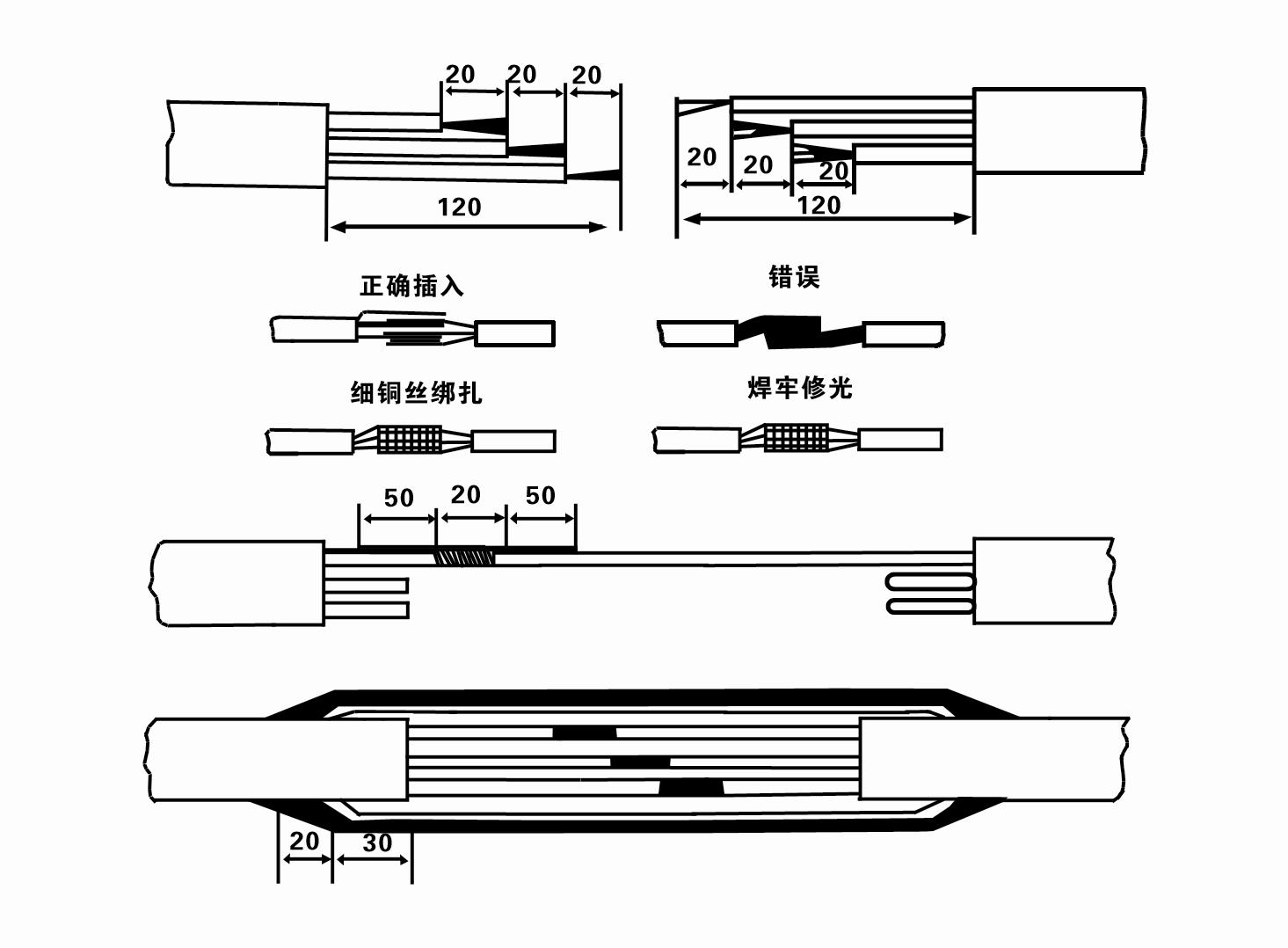
8. E hoʻohana i ka multimeter no ka nānā ʻana inā pili ʻia nā uea ʻekolu ʻāpana a inā ʻaʻole kaulike ke kūpaʻa DC.
9. E nānā inā ua hoʻonui ʻia ka mana kaapuni a me ka mea hoʻololi, a laila hoʻohui i ke kī hoʻomalu overload a i ʻole nā mea hoʻomaka. E nānā i ka Papa 2 no nā hi'ohi'ona kiko'ī, a laila, e ninini i ka bākeke wai i loko o ka pā wai mai ka puka wai e ho'oma'ama'a i ka pahu pahu i loko o ka pama, a laila e kau i ka pauma uwila i lalo i luna a pa'a. a e nānā inā pili ka hoʻokele me ka hōʻailona hoʻokele. Inā ʻaʻole, e hoʻololi i nā mea hoʻohui ʻelua o ke kaula ʻekolu. Inā hoʻohana ʻia i nā hanana kūikawā (e like me nā ʻauwai, nā ʻauwai, nā muliwai, nā loko, nā loko, a me nā mea ʻē aʻe), pono e hoʻopaʻa ʻia ka paila uila.
(2) Mea hoʻokomo a me nā mea hana:
1. Hoʻokahi mau kaulahao hāpai no ʻelua mau tona.
2. ʻO kahi tripod me ke kiʻekiʻe kū i lalo o ʻehā mau mika.
3. ʻElua kaula kau (wire ropes) hiki ke kaumaha i ke kaumaha ma mua o hoʻokahi tona (hiki ke halihali i ke kaumaha o ka pahu wai piha).
4. E hoʻouka i ʻelua mau paʻi (splints).
5. Nā wrenches, hammers, screwdrivers, uila a me nā mea kani, etc.
(3) Hoʻokomo ʻia ka pauma uila:
1. Hōʻike ʻia ke kiʻikuhi hoʻonohonoho o ka pauma uila submersible ma ka Figure 2. Hōʻike ʻia nā ana hoʻonohonoho kikoʻī ma ka Papa 3 "List of Installation Dimensions of the Submersible Electric Pump".
2. Hiki ke hoʻokiʻekiʻe pololei ʻia nā paila uila me ke poʻo ma lalo o 30 mika i loko o ka pūnāwai me ka hoʻohana ʻana i nā paipu a me nā kaula uwea a i ʻole nā kaula hemp ʻē aʻe e hiki ai ke halihali i ke kaumaha piha o ka mīkini holoʻokoʻa, nā paipu wai, a me ka wai i loko o nā paipu.
3. ʻO nā pumps me ke poʻo i ʻoi aku ma mua o 30 mika e hoʻohana i nā paipu kila, a penei ka hoʻonohonoho ʻana:
①E hoʻohana i kahi pipili no ka hoʻopaʻa ʻana i ka ʻaoʻao o luna o ka ʻaoʻao o ka pauma wai (ua hoʻopili ʻia ke kaʻa a me ka pauma wai i kēia manawa), e hoʻokiʻekiʻe me ke kaulahao e kau ana, a nakinaki mālie i loko o ka luawai a kau i ka paʻi ma ke poʻo punawai a wehe i ke kaulahao. kaulahao e kau ana.
② E hoʻohana i nā paipu ʻē aʻe e hoʻopaʻa i ka paipu, e hoʻokiʻekiʻe me ke kaulahao e kau ana ma kahi mamao o 15 knm mai ka lehelehe, a e hoʻohaʻahaʻa mālie. Ma waena o ka flange paipu a me ka flange pump E hoʻopaʻa i ka pā hao a hoʻopaʻa i ka paipu a paʻa pono me nā bolts, nati a me nā mea holoi puna.
③ E hoʻokiʻekiʻe iki i ka pauma hoʻohaʻahaʻa, e wehe i ke kaula ma ka ʻaoʻao o luna o ka pā wai, e hoʻopaʻa paʻa i ke kaula i ka paipu wai me ka lipine plastik, a nakinaki mālie i lalo a kau ʻia ka paʻi ma ka luawai.
④E hoʻohana i ke ʻano like e hoʻopaʻa ai i nā paipu wai a pau i loko o ka pūnāwai.
⑤Ma hope o ka hoʻopili ʻia ʻana o ke kaula alakaʻi i waho i ka hoʻololi mana, ua hoʻopili ʻia i ka lako mana ʻekolu.
(4) Nā mea e nānā ai i ka wā e hoʻokomo ai:
1. Inā ʻike ʻia kahi mea hoʻopuʻi i ka wā o ka pahū ʻana, e hoʻohuli a huki paha i ka paipu wai no ka lanakila ʻana i ke kiko pahu. Inā ʻaʻole e holo nā ʻano hana like ʻole, e ʻoluʻolu, mai hoʻoikaika i ka pamu i lalo e pale aku i ka pōʻino o ka pauma uila a me ka luawai.
2. I ka wā o ka hoʻokomo ʻana, pono e kau ʻia kahi pā hao ma ka ʻaoʻao o kēlā me kēia paipu a paʻa pono.
3. Ke hoʻohaʻahaʻa ʻia ka paila wai i loko o ka pūnāwai, pono e hoʻokomo ʻia i waenakonu o ka paipu pūnāwai i mea e pale ai i ka holo ʻana o ka pamu i ka paia o ka pūnāwai no ka manawa lōʻihi, e hoʻonāwaliwali ai ka pamu a e kahili a wela ke kaʻa. .
4. E hoʻoholo i ka hohonu o ka paila wai a hiki i lalo o ka luawai e like me ke kahe ʻana o ke one a me ka lepo o ka luawai. Mai kanu i ka pamu i ka lepo. ʻO ka mamao mai ka pā wai a hiki i lalo o ka pūnāwai ʻaʻole i emi iho ma mua o 3 mika (e nānā i ke Kiʻi 2).
5. ʻAʻole emi ka hohonu o ke komo ʻana o ka wai ma lalo o 1-1.5 mika mai ke kiʻekiʻe o ka wai ikaika a hiki i ka node inlet wai (e nānā i ke Kiʻi 2). Inā ʻaʻole, hiki ke pohō maʻalahi nā bearings pump wai.
6. ʻAʻole hiki ke haʻahaʻa loa ka hāpai ʻana o ka paila wai. A i ʻole, pono e hoʻokomo ʻia kahi valve puka ma luna o ka pipeline wai punawai e hoʻomalu i ke kahe ʻana o ka paila ma ka helu kahe i helu ʻia e pale ai i ka hoʻonui ʻia ʻana o ke kaʻa a puhi ʻia ma muli o nā kahe kahe nui.
7. I ka holo ana o ka pauma wai, pono e hoomau ka puka ana o ka wai a me ke ano, pono ke kupaa (ma lalo o na kulana hana i heluia, ma ke ano, aole oi aku mamua o 10% o ka manawa i heluia), a aole e haalulu a walawala. Inā loaʻa kekahi mea ʻino, pono ke kāpae ʻia ka mīkini e ʻike i ke kumu a hoʻopau.
8. I ka wā e hoʻokomo ai, e hoʻolohe i ka hoʻonohonoho ʻana o ka uea hoʻopaʻa ʻia kaʻa (e nānā i ke Kiʻi 2). Inā he paipu kila ka paipu wai, e alakaʻi iā ia mai ka puʻu punawai; inā he paipu plastik ka paipu wai, e alakaʻi iā ia mai ka hōʻailona kumu o ka paila uila.
- (1)After installing the submersible pump, it is necessary to recheck the insulation resistance and three-phase continuity of the switch, and check whether there are errors in the connection between the instrument and the starting equipment. If there is no problem, the test machine can be started. After starting, observe whether the indication readings of the instruments exceed the rated voltage and current specified on the nameplate, and observe whether the pump has noise and vibration. If everything is normal, it can be put into operation.
- (2)After the first operation of the pump for four hours, the motor should be shut down to test the thermal insulation resistance quickly, and its value should not be less than 0.5 megaohm.
- (3)After the pump is shut down, it should be started after five minutes to prevent the water column in the pipe from being completely reflowed and causing excessive motor current and burnout.
- (4)After the pump is put into normal operation, in order to prolong its service life, it is necessary to check whether the supply voltage, working current and insulation resistance are normal regularly. If the following conditions are found, the pump should be shut down immediately to troubleshoot.
1 In the rated condition, the current exceeds 20%.
2 Ke hāʻule nei ka pae wai ikaika i ka ʻāpana komo wai, e hoʻoulu ai i ka wai.
3 He haʻalulu koʻikoʻi ka haʻalulu a walaʻau paha ka pauma submersible.
4 ʻO ka haʻahaʻa haʻahaʻa ma mua o 340 volts.
5 Ua pau ka fuse.
6 Poino ka paipu wai.
7 The motor's thermal insulation resistance is lower than 0.5 megaohm.
- (5)Unit disassembly:
- 1 wehe i ke kaula uwea, wehe i ka mahele paipu, wehe i ka pa uwea.
2 E hoʻokuʻu i ka pahu wai, e hoʻokomo i ka wai i loko o ke keʻena kaʻa.
3 e wehe i ka kānana, e wehe i ka wili paʻa ma ka hui ʻana e hoʻoponopono i ke kumu kaʻa.
4 e hoʻokuʻu i lalo i ka bolt e hoʻopili ai i ka hui inlet me ka motika, a hoʻokaʻawale i ka pamu mai ke kaʻa (e hoʻolohe i ka cushion unit i ka wā e hoʻokaʻawale ai, e pale ai i ka piʻo ʻana o ka ʻau pama)
5 ʻo ke kaʻina hoʻokaʻawale ʻana o ka paila: (e ʻike i ka helu 1) ka hui inlet, impeller, diversion shell, impeller...... nānā i ke kino valve, i ka wā e wehe ai i ka impeller, e hoʻohana i nā mea hana kūikawā e wehe i ka lima conical o ka impeller paʻa. ʻO ka mua, a pale aku i ka piʻo ʻana a me ka ʻeha ʻana o ka pahu pahū i ke kaʻina o ka wehe ʻana.
6 ʻO ke kaʻina o ka wehe ʻana o ke kaʻa: (e ʻike i ke kiʻi 1) kau i ke kaʻa ma luna o ke kahua, a wehe i nā nati, ke kumu, ke poʻo laka paʻa, ka pā kī, ke kī, ka noho alakaʻi alakaʻi haʻahaʻa a me ka pahu poʻo pālua mai lalo o ke kaʻa, a laila lawe i ka rotor (e makaʻala i ʻole e hōʻino i ka pūʻolo uea) a hope e wehe i ka ʻāpana hoʻohui a me ka noho alakaʻi alakaʻi luna.
7 unit assembly: before assembly, the rust and dirt of the parts should be cleaned, and the mating surface and fasteners should be coated with sealant, and then assembled in the opposite order of disassembly (the momentum of the motor shaft is about one millimeter after assembly), after assembly, the coupling should be flexible, and then the filter screen test machine. 6. The submersible pump is known for its durability and efficiency, providing you with a lasting pumping solution. When the operating time is more than one year per year, or if the operating time is less than one year, but the immersion time is up to two years, it must be disassembled and inspected in accordance with Article 5 to replace the worn parts. This pump is well designed to ensure efficient operation and reliability, so that you can rest assured. Whether it is used for pumping water from a family pond or pumping water for agricultural irrigation systems, this product can meet your needs. Choose this high-quality pump to keep your pump system in the best condition at all times, ensuring smooth operation and extending its service life.
1, e hoʻoheheʻe i ka wai i loko o ka lua kaʻa (ʻoi loa i ka hoʻoilo e pale ai i ka hau mai ka hau), a nakinaki maikaʻi i ke kaula.
2, store in an indoor room without corrosive substances and gases, with a temperature below 40 °C.
3, pono ka hoʻohana lōʻihi e hoʻolohe i ka pale ʻana i ka ʻōpala o nā paila submersible.
- Mea hoʻolele
- Puʻu lima
- Ka lima lāʻau lāʻau
-
apo apo
01 Hoʻokomo wai hohonu
02 Waiwai kiʻekiʻe
03 lako wai mauna
04 hale kiaʻi wai
05 Ka wai mahiai
06 ka hoʻoulu ʻana i ka māla
07 hoʻokomo wai kahawai
08 wai hale

